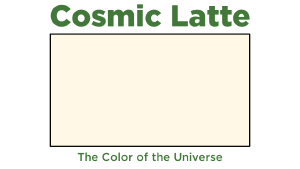Post
Cosmic Latte
23 July 2013
 Brian Koberlein
Brian KoberleinAt the turn of the 21st century, the Anglo-Australian Observatory made a large survey of galaxies in our universe, known as the 2-degree-field galaxy redshift survey (2dFGRS).1 It measured the spectra and redshifts of more than 230,000 galaxies. The main goal of the survey was to determine the distribution of galaxies within a radius of about 4 billion light years. A statistical analysis of this distribution could then be used to put constraints on things like dark matter and neutrino mass (which I’ll talk about another day).
But with the spectra of 200,000 galaxies you can also look at the average spectra of all of them, and in 2001 and 2002, Karl Glazebrook and Ivan Baldry did just that. The average spectrum is useful because it shows the wavelengths that are more common and less common, which in turn tells us the type of spectra stars typically have. This is important because the spectra of a star changes over time. So this gives us an idea of the evolution of stars on average.
Of course you can also take this one step further to determine the color of the universe. You just have to determine the color we would see if we looked at the average spectrum of all the galaxies at the same time. This is a bit more challenging than you might think.
For one, since different galaxies are redshifted by different amounts, you have to account for their redshift. This was done when determining the average spectra of the galaxies, and is pretty straightforward. More challenging is accounting for just how we would observe such a spectra, because sometimes the colors that reach our eyes are not the colors we see.
For example, consider the color yellow. If you look at a yellow square on your computer monitor, your eyes are not actually detecting yellow light. You are actually looking at red and green pixels. The red and green light stimulates the red and green cones in your retina similar to the way truly yellow light stimulates both of them, so the square appears yellow. In a sense, the yellow square on your monitor is a simulated yellow.
Another aspect to deal with is the fact that the sensitivity of our eyes depends on the color. Our eyes are most sensitive in the green region, and less sensitive in the red and blue. Then there is the fact that colors appear differently in different light. When we determine an average color, should it be for daylight adjusted light, dark adapted vision, or some other condition (known as the white point).
Glazebrook and Baldry decided that the best version would be a dark adapted (equal energy) white point, with a gamma correction of 2.2 to account for observed brightness. The result is a pale tan seen in the image above. It represents the color we would see if we could observe all the surveyed galaxies at once (and at rest relative to us). The color was given the name Cosmic Latte.
The color of the universe gradually changes over billions of years. In the past, when the universe was populated with younger stars, the color was lighter and more blue. In the future, as larger stars age and die the color will become darker and more red.
Perhaps in a few billion years we will have to change the name to Cosmic Mocha.
Baldry, Ivan K., et al. “The 2dF galaxy redshift survey: Constraints on cosmic star formation history from the cosmic spectrum.” The Astrophysical Journal 569.2 (2002): 582. ↩︎